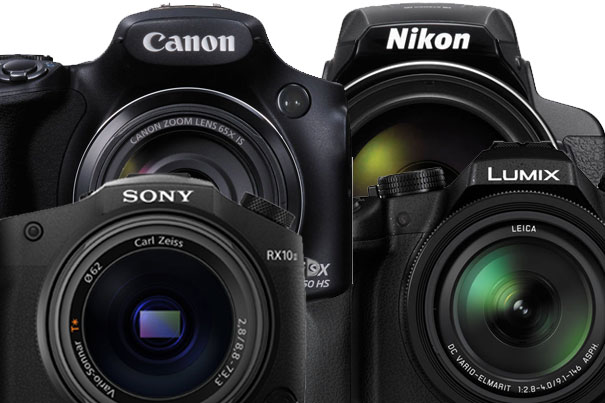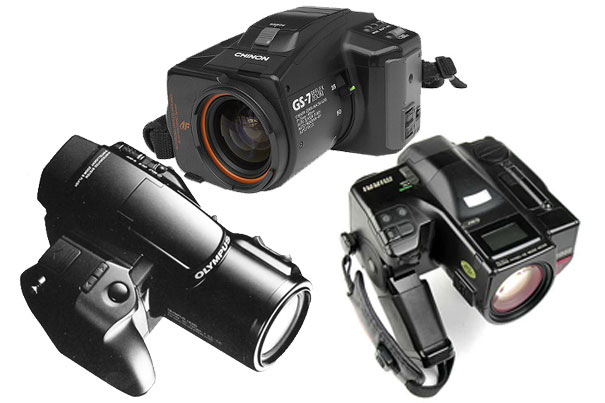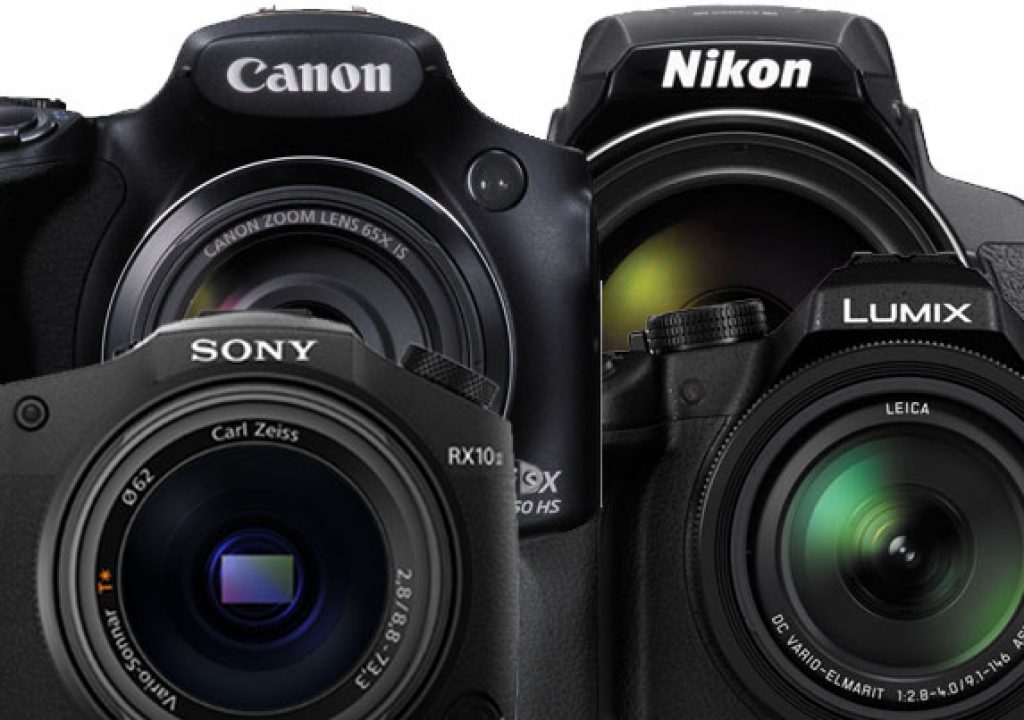
If you want to have the versatility and control of a DSLR in a smaller body and do not need to change lenses, then a bridge camera may be your best friend, also for video, where they can offer some surprising results. That’s what we try to show here, through one guide that looks at the main characteristics of some of the most popular models available in the market.
Bridge cameras, as the name suggests, offer a “bridge” between two worlds: compacts and SLRs. In fact, the name is not even new, being in use since the 1980, with some weird models from brands as Olympus, Ricoh or Chinon (see image), although almost all camera makers had their own versions of bridge-cameras. Bridge cameras were also looked upon as an intermediate point of passage for photographers coming from point-and-shoot models, aspiring for more control, and that would continue their journey to a Single Lens Reflex.

Some of the earlier bridge cameras, from the 1980s, looked like props for a science-fiction movie
Also known as ZLR, or Zoom Lens Reflex, due to the fact that they usually had a camera built around a long zoom lens, these cameras were in fact similar to DSLR, offering a lens – not interchangeable – connected to an optical viewfinder, something that was lost in the modern, digital, bridge cameras. Nowadays, even the meaning of the term “bridge camera” seems lost, and many sources call compact models “bridge cameras”. Confusing, really.
Due to the controls being similar to SLRs, many users would keep on using bridge cameras. When film was the medium it did not matter the size of the “sensor”: it was always 35mm, except for the few APS film models created in the 1990s, like the Olympus Centurion family, which although presented as a SLR was more a bridge, has it had a built-in lens, covering a range from 25mm to 100mm. For a real SLR on the APS format one would have to look at a model like the Minolta Vectis S-1, with interchangeable lenses.
A Olympus bridge camera for the APS film format, and a Minolta Vectis SLR also for APS film, back in 1990s
Although on the path to extinction since 2005, according to some, bridge cameras continue to thrive, and looking at some of the models launched in recent years, this seems to be a niche of the market that still interests most of the players in the industry. Users looking for a system that does all in a single lens, has controls similar to DSLRs and offers more optical quality than a compact camera, should explore the models in this segment for video, and others if photography features are enough for them.
Digital bridge cameras have grown beyond the limits of the original film models, and offer long zooms, with a reach not possible to achieve before. Those super zooms as they are also called, seem to attract the attention of the public, so this is one of the reasons why these models are kept in the market. The most recent bridge cameras also start to offer options like 4K, creating all the conditions to grab the attention of a generation that wants to travel light and have all the photo and video options on a small camera… able to reach distant subjects.
In a world where a film completely made with an iPhone is shown in cinemas – Tangerine, a hit from this year’s Sundance Film Festival – it makes complete sense to look at a bridge camera as a viable option for video. There seem to be no barriers but the cinematographer’s imagination to what can be achieved with the tools we’ve today. There are no right or wrong tools for cinematography: there are different tools and options to achieve results that allows users to reach their goals.
The price/performance of some bridge camera models makes them a good choice for some adventures where you may not want to risk more expensive equipment, for example. But they can also be “your camera” if you understand the limitations and benefits of this “bridge” format. Let’s look at some of the best models available, and what they offer when it comes to video. And yes, we looked first and foremost at models able to do 4K video, but as there are only a few, we included the top of line Full HD models available for brands as Canon, as the company still does not see 4K as essential for the general public. Models from as far back as 2013 are also present, because their relation price/performance makes them a good option for those on a budget. But this list is just a tip of the iceberg, and you should not limit yourself to the models presented here. Use them as a starting point for more explorations.
Canon PowerShot SX60 HS
Canon took the idea of the superzoom to the ultrazoom level with their PowerShot SX60 HS. A 21-1365mm zoom at f/3.4-6.5 (equivalent to 35mm) connected to a 16,1 megapixel High Sensitivity CMOS allows users to photograph and video subjects at very far distances, like no other camera… at the time of launch. Nikon has the crown now, with their 85x zoom…
A long lens like this — 65x — is problematic if not supported by the right technology, as previous models of cameras have shown. Canon claims to have resolved those problems through the use of Intelligent IS, or optical image stabilization, with eight different modes to help ensure sharp photographs and video even at the furthest focal lengths. The DIGIC 6 processor associated with the sensor also helps to achieve good results, improving the capabilities of the camera in low-light and increasing the overall speed of the whole process. The SX60 offers a continuous shooting speed up to 6.4 fps without any need to buffer, and can capture images in JPEG and RAW.
When it comes to video, the PowerShot SX60 has all that is needed: 1080/60p Full HD video capabilities with the choice of automatic or manual exposure control together with a built-in stereo microphone and a port for optional external stereo microphone to record life-like audio with ease. Focusing and zooming are — almost — silent due to the presence of Ultrasonic Motor and Voice Coil Motor.
The Canon PowerShot SX60 HS costs about $480. It weighs 1.43 lb / 649 g with battery and memory card.
For a dying breed, the bridge-camera seems to be doing rather well. So much, in fact, that Nikon created in 2015 the Coolpix P900, the first bridge camera to offer a zoom reaching up to 2000mm (equivalent to 35mm). The powerful 83x optical zoom (24-2000mm at f/2.8 – 6.5 comes associated with a 16 megapixel CMOS sensor.
In addition, it is equipped with Dynamic Fine Zoom, which enables 166x (4000mm) zoom with which resolution is preserved throughout the digital zoom range, and it also supports macro photography of subjects as close as 1 cm to the lens. The P900 supports capture of images exhibiting superior image quality not only when the subject is very far away, but also when it is right in front of the camera. The P900 also offers Moon and Bird-watching scene modes effective with super-telephoto photography. Use of these scene modes allows users to leave all of the work up to the camera when capturing such subjects, with which exposure settings can be difficult to choose and apply, for simple super-telephoto photography.
In addition to its unrivalled zoom power (for now), the 16-megapixel Coolpix P900 comes equipped with an array of innovative features and advanced controls for capturing sharp and detailed images as well as Full HD video from afar. Such features include built-in GPS and the experience of Nikon Snapbridge, whereby users seamlessly shoot and share stunning photos from the camera to a compatible smartphone or tablet via built in Wi-Fi and Near Field Communication technology.
Video on the Nikon Coolpix P900 is just what most users need: Full HD 1080p with stereo audio recording. It is also possible to explore the camera’s innovative Time Lapse feature to capture a beautiful sunrise or sunset video over the course of time. When recording video from afar, the Zoom Microphone function helps to enable clear recording of sounds from a variety of distances. Lastly, the Coolpix P900 makes it easy to document every vacation spot or outdoor adventure as the camera’s built-in GPS and POI allows users to geo-tag images and view where those images were taken on a map.
The Nikon Coolpix P900 is available for a suggested retail price of $599.95. The camera weighs 1.98 lb / 899 g with battery and memory card.
The superzoom concept is something most brands want to have in their line, so Panasonic also created an ultrazoom bridge camera, as far back as 2013, the Lumix DMC-FZ70, with a 60x optical zoom with a range from 20-1200mm at f/2.8-5.9 connected to a 16.1 megapixel High Sensitivity BSI MOS sensor and Venus Engine image processor.
The result is a camera able to produce high resolution still imagery and full HD 1080i/p video with notable low-light quality and with a zoom reach not common on most bridge cameras. Panasonic also claims that the magnification of the lens can be extended further through the use of Intelligent Resolution technology, which effectively renders the zoom ratio to 120x with minimal image degradation.
To achieve the needed stability when using this extensive zoom range, the camera uses POWER O.I.S., the proprietary image stabilization system from Panasonic, which works to minimize the appearance of camera shake when working with greater zoom magnifications. The system also includes an Active Mode able to eliminate camera movement in multiple directions, essential for steady results in HD movies.
In terms of video the Panasonic Lumix DMC-FZ70 records full-HD 1920 x 1080 videos in both AVCHD and MP4 formats. A special, separate button on the top lets you instantly start recording videos while shooting photos without having to make any extra changes. The Creative Video Mode lets you adjust the shutter speed and aperture any way you like when shooting videos. The powerful 60x optical zoom with POWER O.I.S. is available in video recording as well.
Recording video with the FZ70 is easy, but Panasonic did not stop there. The recorded videos come with the highly realistic Dolby Digital Stereo Creator and its sound quality is further improved in the DMC-FZ70 thanks to a newly developed Wind Shield Zoom Microphone that minimizes wind noise by approx. 70% compared to prior models. Externally, the sealed structure prevents wind from hitting the microphone directly and the draft structure suppresses retention of air internally. As a result, the sound is clear and comfortable to listen to even it if was recorded on a windy day.
The Panasonic Lumix DMC-FZ70 is available for about $299. The camera weighs 1.33 lb / 606 g with battery and memory card.
Presented as a long-zoom digital camera, the Panasonic DMC-FZ1000 is a 1” High Sensitivity MOS sensor with 20.1 MP, connected to a 16x Leica DC Vario-Elmarit zoom lens able to reach a 35mm equivalent of 25-400mm at f/2.8-4. ISO range is expandable to 25600.
When it comes to video, the Panasonic DMC-FZ1000, launched in the Summer of 2014, continues to be up to date. The FZ1000 incorporates 4K (QFHD 4K: 3840×2160, up to 30 fps in MP4) video recording capability , a feature where this camera was pioneer when it comes to this type of cameras. Besides, it offers a hybrid photo and video system allowing users to take pictures at 8MP while filming video at 4K.
The FZ1000 incorporates 4K (QFHD 4K: 3840×2160, up to 30 fps in MP4) video recording capability for the first time with a digital compact camera. Panasonic is also proposing a new solution to capture 3840×2160 8-megapixel equivalent images from the 4K video footage which is normally difficult to photograph. Also, videos can be recorded in full-HD 1920 x 1080 60p in AVCHD Progressive (MPEG-4 / H.264) format or MP4 at 60p.
A powerful 16x optical zoom with five-step speed control enables smooth zoom adjustment even while video recording. The five-axis HYBRID O.I.S. (Optical Image Stabilizer)+ with Active Mode effectively compensates for vibration. Creative Video mode, High Speed video in FullHD at 120fps, Time Lapse Shot and Stop Motion Animation are all available for a variety of video effects.
The FZ1000 also features DFD (Depth From Defocus) technology, for its focusing accuracy and improved Light Speed AF of approx. 0.09 sec. Together with the quick start-up time of approx.0.66 sec, the DMC-FZ1000 never misses a shooting opportunity. High speed burst shooting can be shot at 12 fps in 20.1-megapixel full resolution. It also offers a max. 1/4,000 (mechanical) and 1/16,000 (electronic) shutter speed.
In September 2014 Panasonic announced a new firmware update program for the LUMIX DMC-FZ1000. The firmware enhances the performance and controllability of the camera, featuring the new 4K Photo Mode, which extends the control the user has over the photo taking process. The same update also extended the features, with more functional upgrades such as an addition of 4K video recording in 23.98p (MP4, AAC) and 3 new additional options for shutter sound.
The Panasonic DMC-FZ1000 has a price of about $790. It weighs 1.83 lb / 831 g with battery and memory card.
The new Sony Cyber-shot RX10 II, launched recently, keeps the same zoom logic of the RX10, meaning this bridge camera offers a humble optical range compared to some of the new models. In fact, the ZEISS Vario-Sonnar T* lens offers 24-200mm at f/2.8 (35mm equivalent), connected to a 16.1MP 1” sensor which is the world’s first 1.0 type stacked Exmor RS CMOS sensorwith advanced signal processing and an attached DRAM memory chip.
The RX10 II model is one of the first Cyber-shot cameras to offer the advantages of 4K (QFHD 3840×2160) movie recording. The camera utilizes full pixel readout without pixel binning to ensure that all the finer details of 4K video are captured with minimal moire and ‘jaggies’. These high-quality results are achieved through the use of the XAVC S codec, which records video at a high data rate of 100 Mbps during 4K recording and 50 Mbps during full HD shooting.
A first for Sony consumer cameras, the new RX10 II has the ability to record super slow-motion video at up to 40x slower than the standard rate, allowing users to capture and replay fleeting moments of action with incredible detail, resolution and clarity.
Prior to shooting, users will have the ability to choose among 960fps, 480fps and 240 fps frame rates and among 60p, 30p and 24p playback formats to optimize the recording to fit the speed of the moving subject, with the option to use the movie record button as a ‘start trigger’ to begin recording once a button is pressed or ‘end trigger’ to record footage up until the button is pressed. The ‘end trigger’ mode lets shooting begin 2 to 4 seconds before the movie button is pressed, enabling shooters to capture the decisive moment with much more consistency and accuracy. For reference, two seconds of movie footage shot at 960 fps and 24p would take about 80 seconds to play back.
The new Sony Cyber-shot RX10 II high-zoom camera will be available this July for about $1300. It weighs 1.79 lb / 813 g with battery and memory card.
Final note
This guide for bridge cameras is relatively short, but that’s due to the fact that the choice here was predominantly made considering what’s best in terms of video, and looking at models offering some of the most up-to-date features or presented a good option to enter the 4K world. A list for “best bridge cameras” considering general aspects would include other models, as Olympus Stylus SP-100) or Fujifilm FinePix HS50EXR and other brands and models but on a list where video is paramount, it made complete sense to center on the brands that are more popular in the market today.
|
Read also : |


